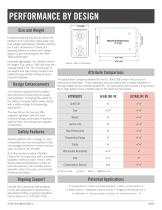
Catalog excerpts

Alkaline 9V or ® ULTRALIFE Lithium 9V The chemistry conundrum
Open the catalog to page 1
9V batteries through the years dioxide chemistry to provide high energy density and voltage that remains very stable throughout discharge. In 1956, the introduction of alloy transistors meant radios that had previously been powered by 22.5V were able to operate from lower voltages. Although originally marketed for vacuum tube hearing aids, the 9V battery found its first home. Proving an instant success, during this fiscal year alone, Ultralife manufactured between 100 to 400K every month. Production continued until 2012 when the design came under scrutiny from Ultralife’s engineers who...
Open the catalog to page 2
ALKALINE 9V Alkaline batteries were invented in 1949 and quickly came to replace early zinccarbon batteries, offering double the energy density with capacity ranging from 500mAh to 800mAh. Mass production of alkaline batteries is often inexpensive, which resulted in common household usage and wide retail store availability. However, with the emergence of lithium battery technology, alkaline has acquired a rival that has a lower service life and does not need replacing as frequently. Alkaline is also less suited than lithium to modern applications that require small and light batteries with...
Open the catalog to page 3
THE WORLD’S LONGEST LASTING Long Storage Life The lithium technology used in the Ultralife Lithium 9V has been shown to offer a shelf life greater than 10 years with little loss of performance. The new lithium 9V has improved construction and technology that assures the battery survives even the harshest of environments. Actual 5-year shelf life data at various capacities and rates is given in figure 1a. A comparison between fresh and 5-year aged Ultralife Lithium 9V batteries impedance and closed-circuit voltage is contained in figure 1b (40 samples). DATA TO 5.4V CUTOFF D0 (Ahrs) LOAD...
Open the catalog to page 4
50% MORE ENERGY High Performance In addition to outperforming alkaline 9V batteries, the Ultralife Lithium 9V is also superior to other lithium competitors. Where the competition offers lithium 9V products that boast 800mAh of capacity, the Ultralife Lithium 9V battery offers 1200mAh or 50% more energy. A test compared Ultralife 9V to other lithium 9V performances (figure 3), using continuous discharge of 1200 ohms at 23°C with regular 20mA pulses. Wide Operating Temperature Range Alkaline batteries have a recommended operating temperature range of -18°C to 55°C. However, the Ultralife 9V...
Open the catalog to page 5
PERFORMANCE BY DESIGN Size and Weight Understanding the demand for lithium 9V batteries to be consumer replaceable, like their alkaline alternatives, Ultralife matched the 9 volt’s dimensions to those of a standard alkaline or carbon zinc battery (figure 5), also conforming to the ANSI 1604 specification. Extremely lightweight, the Ultralife Lithium 9V weighs 37g, approx. 18% less than the average alkaline 9V. The combination of low weight and high energy results in the highest energy density among all brand name 9V batteries. Design Enhancements The internal impedance of the battery was...
Open the catalog to page 6
ULTRALIFE BATTERY & ENERGY PRODUCTS 2000 Technology Parkway Newark New York 14513 United States TEL 800-332-5000 (USA & Canada) TEL +1-315-332-7100 EMAIL sales@ultralifecorp.com WEB www.ultralifecorp.com
Open the catalog to page 7All Ultralife Corporation catalogs and technical brochures
-
Ultralife Thin Cell Brochure
5 Pages
-
Ultralife 9V Infographic
1 Pages
-
Batteries for Robotics
5 Pages
-
Ultralife XR123A Sell Sheet
1 Pages
-
Ultralife CR123A Sell Sheet
1 Pages
-
A-320 20-Watt Amplifier
4 Pages
-
Toll Pass Capabilities
2 Pages
-
Medical Capabilities
2 Pages
-
AN/PRC-117G
3 Pages
-
Metering Capabilities
2 Pages
-
AN/PRC-117F
3 Pages
-
AN/PRC-152
3 Pages
-
MRC-170
1 Pages
-
Communications Solutions
4 Pages


































